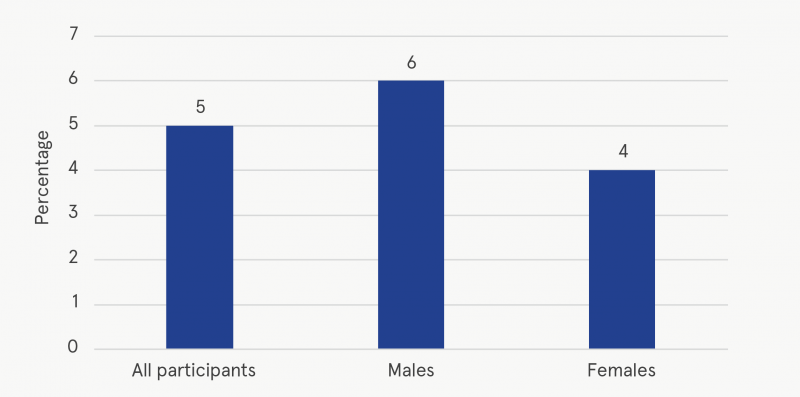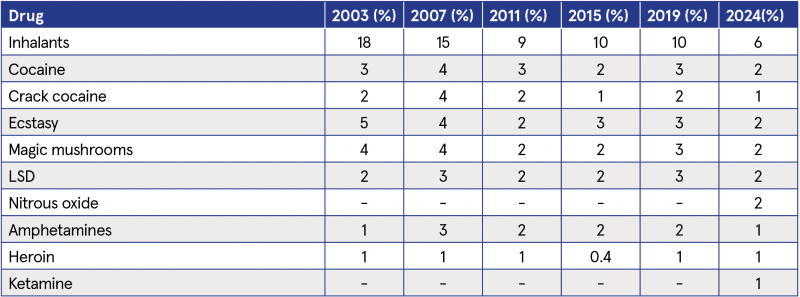Millar, Seán  ORCID: https://orcid.org/0000-0003-4453-8446
(2025)
Substance use among Irish 15–16-year-olds: new findings from the European School Survey Project on Alcohol and Other Drugs, 2024.
Drugnet Ireland,
Issue 92, Autumn 2025, Supplement,
pp. 13-15.
ORCID: https://orcid.org/0000-0003-4453-8446
(2025)
Substance use among Irish 15–16-year-olds: new findings from the European School Survey Project on Alcohol and Other Drugs, 2024.
Drugnet Ireland,
Issue 92, Autumn 2025, Supplement,
pp. 13-15.
| Preview | Title | Contact |
|---|---|---|
|
PDF (Drugnet Ireland 92, supplement)
970kB |
The European School Survey Project on Alcohol and Other Drugs (ESPAD) has conducted surveys of school-going children since 1995, using a standardised method and a common questionnaire. ESPAD Ireland 2024 was conducted in collaboration with the ESPAD Europe Coordinating Team and collected information on the use of alcohol, tobacco, and other substances among 15–16-year-old students.
An important goal of the ESPAD is to monitor trends in substance use and compare trends between countries and groups of countries. It also provides an opportunity to observe trends in substance use among Irish 15–16-year-olds. The rationale for the ESPAD is that school students are easily accessible and are at an age when the onset of substance use is likely to occur.
This article concentrates on substance use findings from the ESPAD conducted in Ireland in 2024, in which 5,587 questionnaires were completed by young people from 28 randomly selected post-primary schools.1 Of these participants, 2,002 were born in 2008 and were included in the international ESPAD dataset. This database was cleaned centrally by the ESPAD Coordinating Team, which resulted in a final analytic sample of 1,880 students in Ireland born in 2008, comparable with students in other ESPAD countries, and used for the analyses presented in this article.
Cannabis use
Participants were asked on how many occasions in their lifetime they had used cannabis. In 2024, 88% of students reported never using cannabis, while almost one in eight students (12%) had ever used it. In the total student population, 4% had used it 1–2 times, and 3% had used it at least 20 times. No significant sex differences were observed in lifetime cannabis use. Trends over time suggest that lifetime cannabis use among school-aged children in Ireland has stabilised and is greatly reduced since 2003, with a 69% reduction between 2003 and 2024 (see Table 1).
Table 1: Lifetime prevalence of cannabis use among 15–16-year-olds in Ireland, ESPAD 2003–2024

Source: ESPAD Ireland (2025)
Nearly one-third of students (29%) reported that obtaining cannabis would be ‘fairly easy’ or ‘very easy’, while 19.3% believed it would be ‘impossible’. Age 14 years was the most frequently reported starting age (4%), and females were more likely to start using cannabis at age 14 years (5%), while male students were more likely to start using cannabis at age 15 years (5%). Among those who had used cannabis in the last 12 months (10%), 3.3% had often mixed it with tobacco.
Overall, 4.9% of students had used cannabis in the last 30 days, with 6% of males reporting last-month use, compared with 4% of females (Figure 1). In the total population, 2% had used cannabis 1–2 times, and 1% had used cannabis at least 20 times in the last 30 days. No significant sex differences were found in cannabis use frequency during this period.

Figure 1: Cannabis use in the last 30 days among 15–16-year-olds in Ireland, ESPAD 2024
Source: ESPAD Ireland (2025)
Students were also asked about indicators of problem cannabis use in the last 12 months, using the Cannabis Abuse Screening Test (CAST). The CAST score measures the possible presence and extent of cannabis-related problems. Originally designed for teenagers, this test was adopted in 2007 by the ESPAD, and its psychometric properties have been assessed in representative samples of teenagers in several European countries.2 Among the total sample (both users and non-users of cannabis in the last 12 months), 4% of students were classified as having high-risk cannabis use using this metric, and 96% were classified as being at low or no risk.
Other substance use
Regarding lifetime use of other substances, inhalants were the most commonly used substance, after cannabis, at 6%. The next most commonly used drugs were cocaine, ecstasy, magic mushrooms, lysergic acid diethylamide (LSD) and nitrous oxide, all at 2% (see Table 2).
An analysis of trends indicates an overall decrease in the use of most substances since 2003 among Irish 15–16-year-olds.
Table 2: Lifetime use of substances (other than cannabis) among 15–16-year-olds in Ireland, ESPAD 2003–2024

Source: ESPAD Ireland (2025)
Conclusion
In summary, the results from the 2024 ESPAD indicate a reduction in the use of cannabis, inhalants, and other substances. Nevertheless, it should be noted that early school-leavers, a group known to be vulnerable to drug use, are not represented in this survey. Consequently, the results may not indicate the true extent of drug use among all 15–16-year-old children in Ireland.
1 Hanafin J, Sunday S, Fitzmarice H and Clancy L (2025) ESPAD Ireland 2024: results from the European School Survey Project on Alcohol and Other Drugs. Dublin: TobaccoFree Research Institute Ireland for the Department of Health Ireland. Available from: https://www.drugsandalcohol.ie/43291/
2 Legleye S, Eslami A and Bougeard S (2017) Assessing the structure of the CAST (Cannabis Abuse Screening Test) in 13 European countries using multigroup analyses. Int J Methods Psychiatr Res. 26(1):e1552.
B Substances > Cannabis / Marijuana
B Substances > Hallucinogens / Psychedelics > LSD (Lysergic acid diethylamide)
B Substances > Hallucinogens / Psychedelics > Mushrooms (psilocybin)
B Substances > Inhalants and solvents
B Substances > Inhalants and solvents > Nitrous oxide (laughing gas)
B Substances > CNS stimulants > Amphetamines
B Substances > CNS stimulants > MDMA / Ecstasy
B Substances > Cocaine
B Substances > Cocaine > Crack cocaine
B Substances > Opioids (opiates) > Heroin (diacetylmorphine / diamorphine)
B Substances > New (novel) psychoactive substances > Aminoindanes / Arylalkylamines / Arylcyclohexylamines > Ketamine
J Health care, prevention, harm reduction and treatment > Risk and protective factors > Risk factors
T Demographic characteristics > Adolescent / youth (teenager / young person)
VA Geographic area > Europe > Ireland
Repository Staff Only: item control page